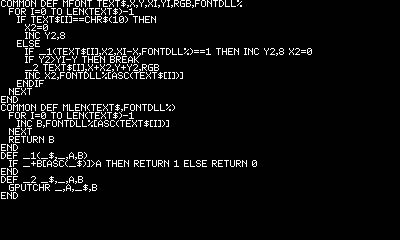
Your description "This project shortens text" doesn't really convey what your library does.
Root / Submissions / [.]

DIM FONTDLL%[65536] LOAD"GRPF:SBMULTI.FON",0 LOAD"DAT:SBMULTI.DLL",FONTDLL%,0 EXEC"PRG1:MFONT.LIB"P.S. If you want the MFONT2 library, just replace the MFONT.LIB with MFONT2.LIB Commands:
MFONT TEXT$,X,Y,XI,YI,RGB,FONTDLL%XI/YI: The edge of X/Y (Basically a box) FONTDLL: Just put in the FONTDLL array above
MLEN(TEXT$,FONTDLL%)This outputs the length of the text with the FONTDLL Multifont 2 library:
MFONT2 TEXT$,X,Y,XI,YI,FONTDLL%Just like MFONT, but has more features. (The features are in the TEXT$ string) %B: Changes the bold feature (e.g. %B1) %C: Changes the color (e.g. %CFFFFFF) %S: Changes the character spacing (e.g. %S3) %X: Changes the width of the text %Y: Changes the height of the text %P: Changes the allocated length of a special command (Exept for %C) (e.g. %P2%S10) &: Specifies as an escape character


 kevinfoley
kevinfoley kevinfoley
kevinfoley kevinfoley
kevinfoley